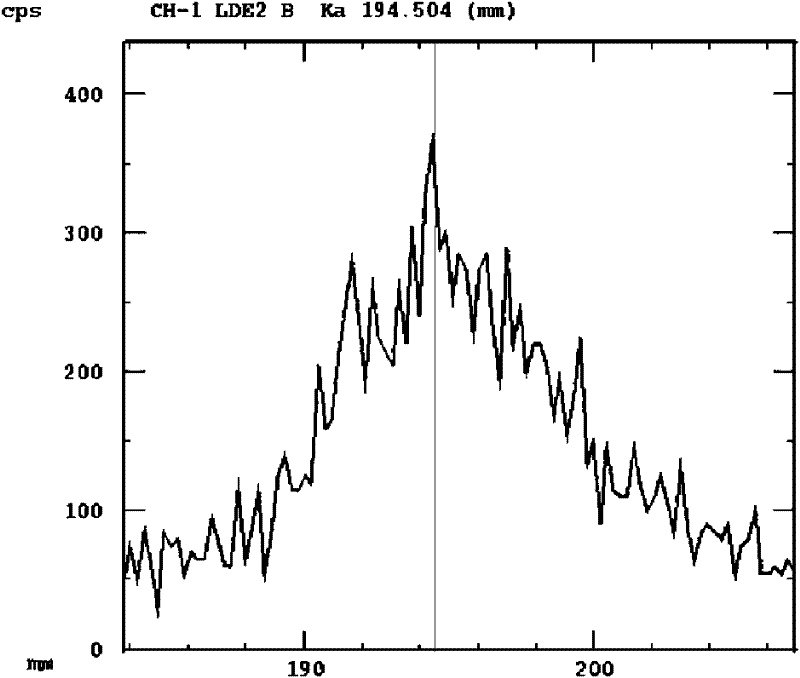Quantitative analysis method for detecting boron content by electron probe
An electronic probe and quantitative analysis technology, which is applied to the use of wave/particle radiation for material analysis, measuring devices, electrical components, etc., can solve problems such as difficult element analysis, poor penetration ability, and high background strength
- Summary
- Abstract
- Description
- Claims
- Application Information
AI Technical Summary
Problems solved by technology
Method used
Image
Examples
Embodiment 1
[0023] The first step is to prepare the sample zirconium boride (ZrB 2 );
[0024] In the second step, according to the sample injection requirements of the electron probe, the sample zirconium boride (ZrB 2 ) into the sample stage of the electron probe;
[0025] The third step is to set a series of quantitative analysis conditions such as accelerating voltage and electron beam current, among which the accelerating voltage is set to 6KV, 8KV, 10KV, 12KV, 15KV, 18KV, 20KV, and the electron beam current is set to 2×10 -7 A, Quantitative analysis test was carried out, and the test results are listed in Table 1.
[0026] Discussion of test results:
[0027] In the test, multiple acceleration voltage values of 6KV, 8KV, 10KV, 12KV, 15KV, 18KV, and 20KV were used for ultra-light element analysis and peak-finding. The purpose is to find the best acceleration voltage value to obtain the maximum peak count. From figure 1 It can be seen from the experimental data in Table 1 that ...
Embodiment 2
[0031] The first step is to prepare the sample hafnium boride (HfB 2 );
[0032] In the second step, the prepared sample is loaded on the sample stage of the electronic probe according to the sampling requirements of the electronic probe;
[0033] The third step is to set a series of quantitative analysis conditions such as accelerating voltage and electron beam current, among which the accelerating voltage is set to 6KV, 8KV, 10KV, 12KV, 15KV, 18KV, 20KV, and the electron beam current is set to 2×10 -7 A, Quantitative analysis test is carried out, and the maximum peak count obtained is shown in Table 2.
[0034] Table 2 Counting of boron element peaks in hafnium boride under different accelerating voltages
[0035]
[0036] Discussion of test results:
[0037] From the experimental data in Table 2, when the accelerating voltage is 10KV, the peak count is the highest. Therefore, 10KV is the best accelerating voltage value for boron electron probe quantitative analysis. ...
Embodiment 3
[0039] The first step is to prepare the sample nickel boride (Ni 2 B);
[0040] In the second step, according to the sample injection requirements of the electronic probe, the sample nickel boride (Ni 2 B) on the sample stage of loading electron probe;
[0041] The third step is to set a series of quantitative analysis conditions such as accelerating voltage and electron beam current, among which the accelerating voltage is set to 6KV, 8KV, 10KV, 12KV, 15KV, 18KV, 20KV, and the electron beam current is set to 2×10 -7 A, Quantitative analysis test is carried out, and the maximum peak count obtained is shown in Table 3.
[0042] Table 3 Nickel boride (Ni 2 B) Boron element peak count and upper and lower background values
[0043]
[0044] Discussion of Test Results
[0045] From the experimental data in Table 3, when the accelerating voltage is 10KV, the peak count is the highest. Therefore, 10KV is the best accelerating voltage value for boron electron probe quantitati...
PUM
 Login to View More
Login to View More Abstract
Description
Claims
Application Information
 Login to View More
Login to View More - Generate Ideas
- Intellectual Property
- Life Sciences
- Materials
- Tech Scout
- Unparalleled Data Quality
- Higher Quality Content
- 60% Fewer Hallucinations
Browse by: Latest US Patents, China's latest patents, Technical Efficacy Thesaurus, Application Domain, Technology Topic, Popular Technical Reports.
© 2025 PatSnap. All rights reserved.Legal|Privacy policy|Modern Slavery Act Transparency Statement|Sitemap|About US| Contact US: help@patsnap.com



